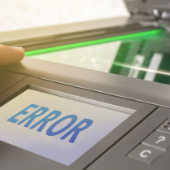
Paper jams
Paper jams are a common printer problem caused by misaligned paper in the printer tray. Usually, removing the jammed paper and ensuring that the paper is lined up correctly will fix the problem.
Check your printer’s loading capacity as well. The loading capacity typically depends on the material to be printed on. For instance, a printer can print on 100 sheets of plain paper, but can only accommodate 10 envelopes at a time. To avoid jams, make sure to use only the paper sizes and materials prescribed by the printer company.
Lastly, if your printer says there’s a paper jam but no paper is stuck inside, shredded paper residues from the last paper jam could be stuck inside the printer’s gears. Remove them before trying to print again.
Driver problems
The printer driver is responsible for communicating with your computer. Drivers often become outdated or incompatible with your system after an upgrade. Sometimes, you may install an incorrect driver, which can cause the printer to misbehave.
To fix the problem, try uninstalling the faulty driver and replacing it with the appropriate one. You can usually find printer driver information on your printer manufacturer’s support website. Avoid downloading drivers from a third party, as they may be loaded with malware that can cause your computer to malfunction.
Overloaded print queue
There are some instances where your printer fails to clear its queue. If you encounter a paper jam, for instance, the system will not consider the print job done. And if the user attempts to print again, the previous job will not make way for the new request. The worst part? Deleting the print jobs doesn’t do anything most of the time.
To clear the print queue, follow these steps:
- Turn off and unplug your printer from the power source.
- Click the Start button on your computer and type in services to open Windows Services.
- Right-click on Print Spooler and select Stop from the menu that appears. This will halt any stuck print jobs in the queue.
- Open File Explorer on your computer, and type in C:WindowsSystem32SpoolPRINTERS in the address bar. Delete all the existing files inside the folder.
- Restart your computer and printer. Try printing again.
Clogged printheads
Printhead ink will dry up if you don’t regularly use your printer. This may lead to clogging, which then prevents proper printing. To make sure this issue doesn’t happen, unclog your printheads often.
The printhead is located at the end of the cartridge where the ink comes out. To clean it, take a damp paper towel and blot the ink cartridge with the printhead side down. After blotting it a couple of times, you should see ink on the paper towel. Hold the cartridge against a dry paper towel for one minute to dry out any excess ink. Slide the cartridge back into the printer and try to print again.
For printers using individual color cartridges, running a printhead cleaning job can get rid of clogs. While the setup may differ per brand, this is a typical function built into most printers’ software. Consult your user guide to know the best cleaning options for your printer.
Slow printing speed
Slow print jobs are usually caused by outdated software or an intermittent connection. Fix the problem by ensuring that printer drivers and software are updated. If your printer requires an internet connection, you can also try moving your printer closer to your router for a stronger connection.
Check your printer settings as well. For instance, you may be printing at best quality, which takes more time than a draft or normal print because it uses more ink.
If all else fails, check your connections to see if a cable or a power outlet is malfunctioning.
These are just some common problems that you may encounter with your printer. If you have further issues, give us a call today. We’d be happy to assist you.

